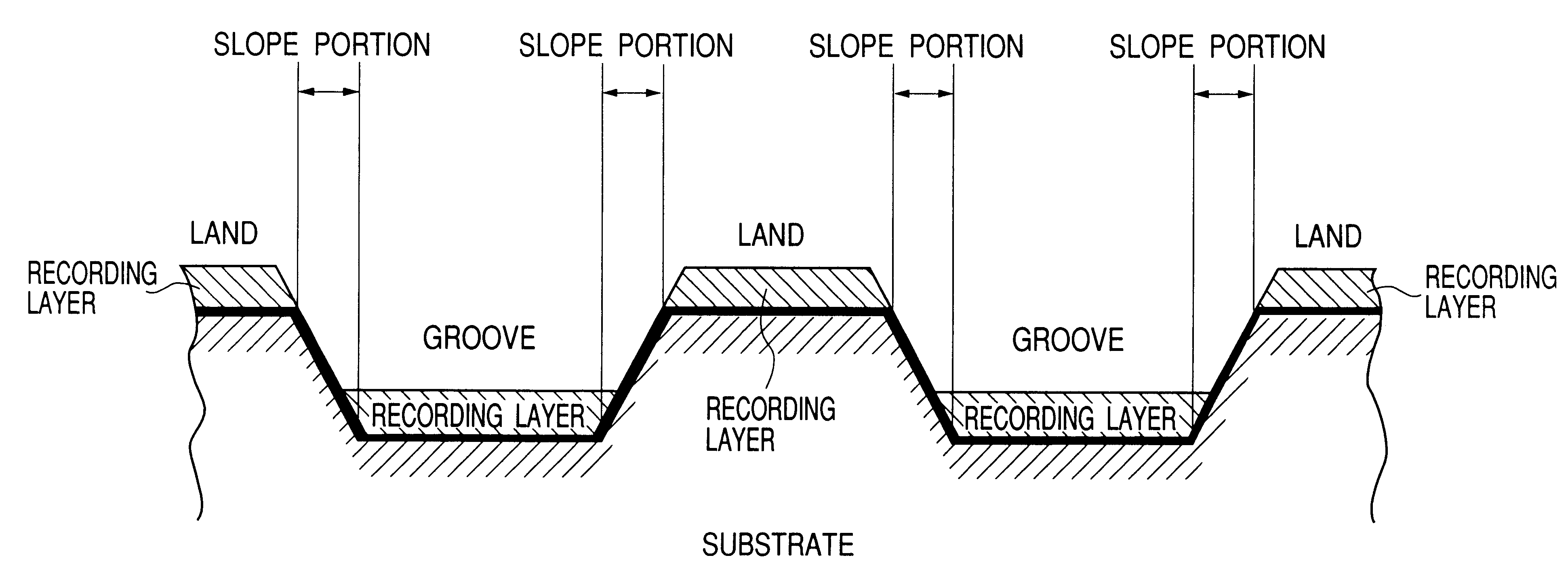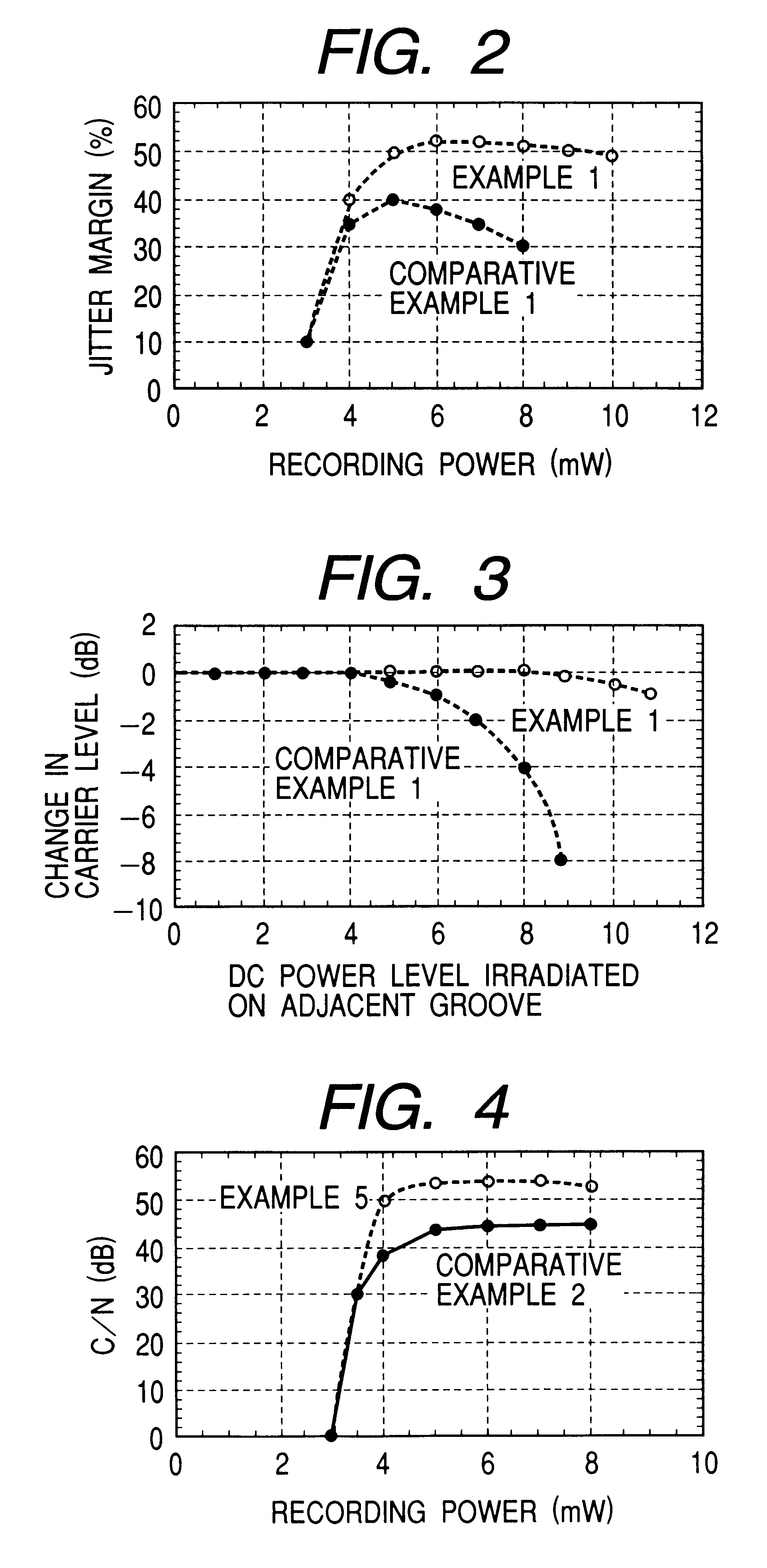Information recording medium and method for producing the same
a technology of information recording medium and information recording medium, which is applied in the direction of magnetic materials for record carriers, light beam reproducing, instruments, etc., can solve the problems of destroying information pits preserved on adjacent tracks, unable to properly reproduce original information, and complicated recording means
- Summary
- Abstract
- Description
- Claims
- Application Information
AI Technical Summary
Problems solved by technology
Method used
Image
Examples
embodiment 1
To improve productivity in the steps of Embodiment 1, it is better for the time required for etching to be as short as possible. A film forming step in which the recording layer is not laminated even if etching is not done is desirable.
For that purpose, it is preferable to adopt a film forming method which is as great as possible in the non-isotropy of the film forming speed and strong in directionality. For example, a film forming method such as the evaporation method which is capable of forming film basically in high vacuum is strong in directionality because particles emerged from the source keep travelling straight on. Also, even when the sputter method is used, low pressure sputter can be adopted or the applied voltage to the targets can be made high to thereby reduce the rate of going round and enhance directionality.
Further, it is also possible to use the collimate sputter method in which a grating-like collimate electrode is disposed in a film forming chamber in a direction ...
embodiment 2
Use was made of a substrate similar to that of Embodiment 1, with the exception that the pitch of the grooves was 1.1 .mu.m and the angle of inclination of the slope portions with respect to the surface of the substrate was about 76.degree.. The pressure of Ar gas during the formation of TbFeCo layer was 0.1 Pa, the supplied power to the targets was 1500 W, and the film was formed so that the film thickness might be 20 nm. Thereafter, a sample was made in the same manner as Embodiment 1, with the exception that without etching being effected, an SiN layer and an Al layer were formed.
In this sample, the angle of inclination of the slope portions of the substrate with respect to the surface of the substrate is great, the rate of going round during the formation of the TbFeCo layer is reduced, and the directionality is high and therefore, the recording film adheres only slightly to the slope portions even if etching is not effected.
When this sample was evaluated by a method similar to ...
embodiment 3
In Embodiment 2, the Al layer to be formed last was formed to a film thickness of about 100 nm. Thereafter, CCl.sub.4 was introduced as a reactive gas and the Al layer was etched by the plasma etching method until the film thickness thereof became about 50 nm. By this etching, the Al film on the slope portions was completely removed and the SiN layer formed immediately before it became exposed. Next, CF4 was introduced as a reactive gas, and this SiN layer was removed by the plasma etching method. As the result, a TbFeCo recording film slightly adhering to the slope portions became exposed. In the present embodiment, this recording film was not physically removed, but it was exposed to reactive gas for a predetermined time, whereby it was chemically changed in quality and the magnetism thereof was made to disappear so that it might not function as a recording film. When the sample thus made was evaluated by a method similar to that of Embodiment 1, an effect equal to that of Embodim...
PUM
| Property | Measurement | Unit |
|---|---|---|
| Angle | aaaaa | aaaaa |
| Angle | aaaaa | aaaaa |
| Temperature | aaaaa | aaaaa |
Abstract
Description
Claims
Application Information
 Login to View More
Login to View More - R&D
- Intellectual Property
- Life Sciences
- Materials
- Tech Scout
- Unparalleled Data Quality
- Higher Quality Content
- 60% Fewer Hallucinations
Browse by: Latest US Patents, China's latest patents, Technical Efficacy Thesaurus, Application Domain, Technology Topic, Popular Technical Reports.
© 2025 PatSnap. All rights reserved.Legal|Privacy policy|Modern Slavery Act Transparency Statement|Sitemap|About US| Contact US: help@patsnap.com



